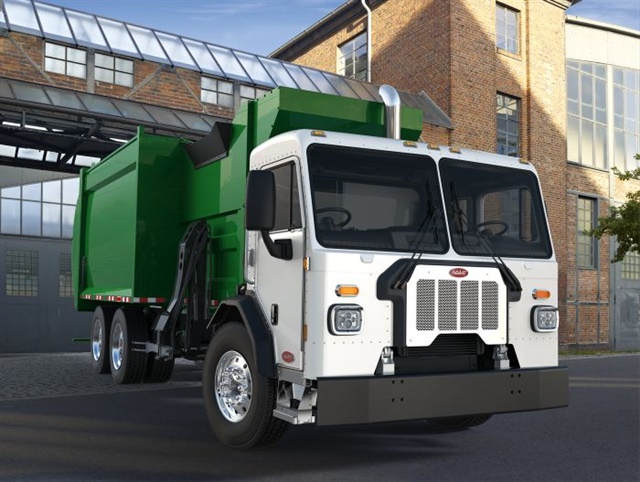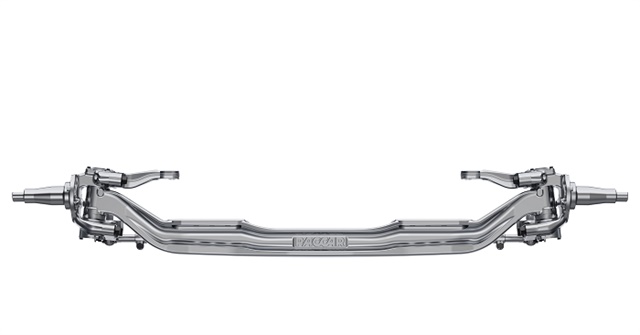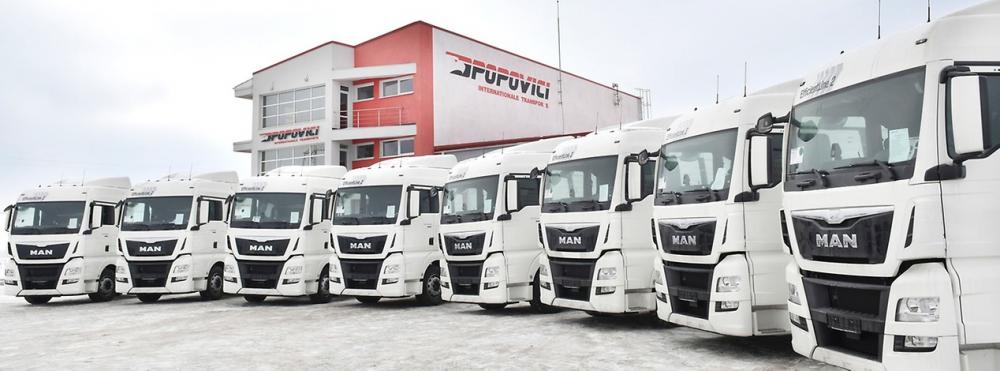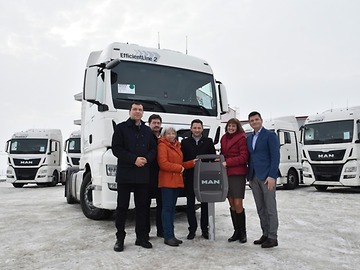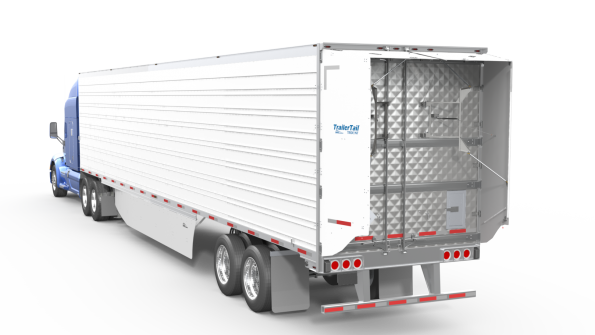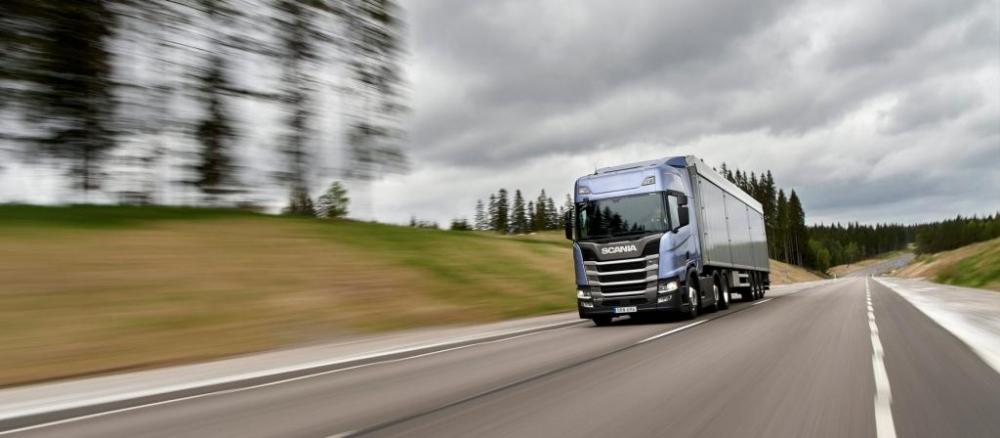
kscarbel2
Moderator-
Posts
18,886 -
Joined
-
Days Won
114
Content Type
Profiles
Forums
Gallery
Events
Blogs
BMT Wiki
Collections
Store
Everything posted by kscarbel2
-
Heavy Duty Trucking / May 9, 2017 Peterbilt showcased three new cab configurations of the Model 520 refuse truck and displayed a battery-electric demo version at the WasteExpo 2017 show in New Orleans. The Model 520 is now available in left-hand drive, right-hand drive, and right-hand stand-up drive configurations in addition to the existing dual-seated drive configuration. The left-hand drive and right-hand drive configurations are designed to provide a comfortable seated driving position for the driver while in transit or performing curbside operations. The redesigned right-hand stand-up cab configuration provides easier ingress and egress for those applications that require the driver to exit the cab multiple times during a route. "The Model 520 provides superior performance and adaptability in rugged operating environments," said Robert Woodall, Peterbilt’s assistant general manager of sales and marketing. "Offering a full lineup of cab configurations for the refuse market further enhances the versatility of this vocational vehicle for our customers’ operations." The company also displayed a Model 520 refuse truck demo with an advanced battery-electric drive system. The truck was equipped with a Transpower ElecTruck drive system that uses high-power electric motors, inverters, and batteries to power commercial trucks weighing as much as 80,000 pounds. "Peterbilt is working closely with its partners to explore the capabilities and performance of battery-electric drive systems," said Scott Newhouse, Peterbilt chief engineer. "Customers in urban environments and applications such as drayage and refuse collection stand to benefit from the zero-emissions performance of these advanced vehicles." The version of the drive system developed for the Model 20 uses a 300-kilowatt-hour battery pack that offers up to 65 miles or eight hours of operation on a single charge during urban refuse use. The ElecTruck system also features a 70-kilowatt onboard battery charger that can fully charge the truck’s lithium-ion battery pack in two to four hours. "Powering heavy refuse trucks is a logical next step in the adaptation of our electric drive technology to vehicles requiring conversion to zero-emission operation," said Joshua Goldman, TransPower’s vice president of business development. .
-
Heavy Duty Trucking / May 9, 2017 Peterbilt has added a Paccar brand 20,000- and 22,000-pound wide track steer axles to its vocational lineup. The Paccar steer axle is available with standard front air disc brakes or optional drum brakes as well as suspensions and wheel end options to meet the application’s demands. Both axle ratings will be available in the Models 567, 520, 389, 367, 365, 348, and the 389 glider kit. The axle is designed for vocational applications such as refuse, construction, and heavy-haul, featuring a combination of weight savings technology and durability. The steer axle is designed for high maneuverability with a turn angle of up to 50 degrees. “The Paccar steer axle continues the Peterbilt tradition of innovative and rugged products for our vocational customers who demand maximum performance,” says Kyle Quinn, Peterbilt general manager and Paccar senior vice president. “Whether we’re reducing total cost of ownership or increasing payload, Peterbilt is continuously looking for solutions that maximize our customers’ uptime and profitability.” .
-
Navistar reveals new Class 8 regional haul tractor
kscarbel2 replied to kscarbel2's topic in Trucking News
Around and inside Navistar's RH regional haul tractor Aaron Marsh, Fleet Owner / May 9, 2017 It was hard to miss one of Navistar's new RH regional haul tractors on display at the National Private Truck Council's (NPTC) 2017 Annual Conference (and Fleet Owner certainly didn't). The RH will feature as standard the OEM's new 12.4L A26 diesel engine. Navistar unveiled the RH on April 20 in Montreal, and production is slated to begin in June. Come with us and take a look around, under the hood and inside the new tractor, which on the company noted it developed "based a study of interaction points between the driver and truck — everything from what a driver sees to how he moves and reacts in virtually any situation." Photo Gallery - http://fleetowner.com/equipment/around-and-inside-navistars-rh-regional-haul-tractor#slide-0-field_images-218071 -
A tour of two new Volvo VNRs Aaron Marsh, Fleet Owner / May 9, 2017 Volvo Trucks rolled out two of its new VNR tractors — one a VNR 300 daycab and the other a VNR 640 with 61" sleeper — at the National Private Truck Council's (NPTC) Annual Conference last week. Volvo designed the VNR lineup with particular emphasis on the driver "environment," so we took the opportunity especially to check out the larger sleeper model and driver accommodations. The OEM clearly spent a good deal of time on the details here; follow along with us to take a tour of some of them. Photo Gallery - http://fleetowner.com/equipment/tour-two-new-volvo-vnrs#slide-0-field_images-218061
-
. . . . .
-
Torture and starve to death a child and feed him to pigs, and you only get 25 years. What a justice system we have. Prompt execution by guillotine immediately following the trial would have sent a clearer message. ------------------------------------------------------------------------------------------------------ Kansas man jailed for killing and torturing son he fed to pigs BBC / May 9, 2017 A judge in Kansas has sentenced a man to life after he was convicted of murdering his seven-year-old son, torturing him and recording the abuse. Michael Jones, 46, must serve 25 years for killing his son Adrian. The boy's step-mother, Heather Jones, 31, has already been jailed for the same crime. Officials say Adrian endured horrific torture in his last year of life, and was fed to pigs after his death. A Kansas politician has introduced a law requiring people to report abuse. Representative Louis Ruiz introduced Adrian's Act, which would require family members or residents of the household to report abuse to authorities. Under current Kansas law, only "mandated reporters", such as healthcare workers, teachers, social workers, and law enforcement officers are obligated to report abuse. "If you witness child abuse, I don't care if you're a mandated reporter or not, we should report these things," said Adrian's grandmother, Judy Conway, who praised the bill. The little boy's remains were found in a barn on a property rented by the Jones family in November 2015. He is believed to have died from starvation months earlier. Investigators had gone to the home after receiving reports of domestic abuse. While the couple was awaiting trial, their landlord discovered photos and videos on their computer meticulously documenting the horrific abuse Adrian had endured. During sentencing, Detective Stuart Littlefield choked back tears as he described the final year of Adrian's life, which he said was the worst crime he had seen in his 23-year career. "Imagine the screams of a 7-year old boy", Mr Littlefield said describing the abuse. "And when his killers could no longer stand the stench of his body he was fed to pigs," he said. .
-
Daimler drops bid to win approval to sell U.S. 2017 Mercedes diesels Reuters / May 9, 2017 Daimler AG said on Tuesday it had dropped plans to seek U.S. approval to sell 2017 Mercedes-Benz U.S. diesel models, but had not decided whether to exit the American passenger diesel market. "We constantly review our portfolio offerings and make adjustments to meet immediate customer need," Mercedes-Benz USA spokesman Rob Moran said in an email. "Combined with the increased effort to certify diesel engines in the U.S., we have put the certification process for diesel passenger cars on hold." There has been growing scrutiny of diesel vehicles in the U.S. since Volkswagen AG admitted in September 2015 to installing secret software on 580,000 U.S. vehicles that allowed them to emit up to 40 times legally allowable emissions. VW was sentenced in April after pleading guilty in the emissions scandal. In total, VW has agreed to spend up to $25 billion in the U.S. to address claims from owners, environmental regulators, states and dealers and offered to buy back about 500,000 polluting U.S. vehicles. Last month, Daimler said investigations by authorities of diesel emissions and auxiliary emission control devices could lead to significant penalties and recalls. The U.S. Justice Department, EPA, California Air Resources Board and a prosecutor in Stuttgart, Germany, are investigating emissions of Mercedes-Benz diesel vehicles. In March, the Stuttgart prosecutor launched an investigation against Daimler employees on suspicion of fraud and misleading advertising tied to vehicle emissions. The company told Automotive News in October that it planned to seek approval to sell four U.S. Mercedes diesel models for the 2017 model year. Last year, Mercedes-Benz offered four U.S. diesel models. In April, Dietmar Exler, CEO of Mercedes-Benz USA, told reporters the company had not made a decision "one way or the other" on the future of U.S. diesel sales. Moran said diesel vehicles in the U.S. in 2016 accounted for less than 1 percent of U.S. sales and the company could still opt to seek 2017 certification at a later date. The company is "leaving the door open to offer diesels as a potential option in our passenger cars and SUVs." Daimler won approval in late April to sell U.S. diesel Sprinter commercial vans after months of talks with regulators. In January, the EPA and CARB accused Fiat Chrysler Automobiles of illegally using software to allow excess diesel emissions from 104,000 U.S. trucks and SUVs. Regulators have refused to grant FCA approval to sell 2017 U.S. diesel models.
-
Jacobs Vehicle Systems Press Release / May 9, 2017 Jacobs Vehicle Systems, the world’s leading manufacturer of diesel and natural gas engine retarding systems and valve actuation mechanisms, has just signed a new long term agreement with Daimler Trucks North America (DTNA) to ensure this long standing partnership continues well into the future. With this new long term agreement, Jacobs and Daimler continue their long-standing relationship which began in 1962 when engine brakes were first installed on a Detroit Diesel Series 71 engine in an aftermarket application. Since the early 1980s, Jacobs Engine Brakes® have been standard equipment starting with the joint development of the Detroit Diesel S60 engine platform in 1984 and more recently the Daimler global engine platform that launched in 2007, where the Detroit DD13 [M-B OM471], DD15 [OM472] and DD16 [OM473] engines are available in Daimler Trucks North America vehicles. “This type of longevity would not exist without the strong collaboration between our engineering and commercial teams,” said Steve Ernest, Vice President, Engineering and Business Development at Jacobs Vehicle Systems. “When you combine Daimler’s world-class engineering team and global market presence with the world’s leading engine braking technologies, the end result can only drive success.” The engine braking system represents the most advanced engine braking technology available on the market, and it is designed for high performance, rapid response, and extreme durability. In addition, the design is modular which allows for technology to be seamlessly adapted as market demands change. “We are extremely proud of what we have been able to accomplish with Daimler,” said Paul Paré, Director, Marketing at Jacobs Vehicle Systems. “Working with Daimler from the earliest stages of development can only lead to future benchmark products that meet the demands of our customers. This relationship is a testament to the global leadership of the Jake Brakebrand.”
-
MAN Truck & Bus Press Release / May 8, 2017 At the end of 2016, MHS Truck & Bus Group Romania started a successful partnership with Int. Transporte Popovici S.R.L. | As part of the partnership Int. Transporte Popovici S.R.L. has taken over a total of 101 TGX tractors For 2 decades the company Int. Transporte Popovici S.R.L. relied its activity on the MAN premium products.The transport company has been operating in the international transport sector since 1997 and is offering a wide range of services from the FMCG transport to the specialized transport (e.g. frigo transport or bulk goods transport). “During our 20 years activity, we have been working constantly with MAN, our partner and supplier for the transport means. Starting with 2016, we decided to purchase 101 truck tractors from the Romanian MAN importer – MHS Truck & Bus Group. Regarding the financing solutions, we relied again on the services of MAN Finance, provided by Porsche Finance Group Romania. We are pleased not only with the quality of their products but also with their services on which we rely the development of our transport activity”, stated Sarolta Bara, General Manager of Int. Transporte Popovici S.R.L. The 101 truck tractors fleet, purchased from MHS Truck & Bus Group consists of MAN TGX 18.480 4x2 BLS units. The XLX driver friendly cabin with air conditioning, the D26 engine with 2500 Nm torque, the cost effective systems MAN EfficientCruise and EfficientRoll and the safety systems: Electronic Stability Program (ESP), Emergency Brake Assistant (EBA) and Lane Guard System (LGS) provide the perfect match for a economic and efficient long haul truck tractor fleet. "Starting with 2016, MHS Truck & Bus Group began a successful partnership with one of the most important transport companies operating in Romania – Int. Transporte Popovici S.R.L. We are very pleased to work with such a successful and reliable transport company, and we assure our partner of our full support.” stated Mr. Miloš Vujanović, CEO of MHS Truck & Bus Group Romania, the MAN importer in Romania. Part of the 101 units were delivered during 2016, the last 15 units being handed over at the beginning of February 2017 at the headquarter of the transport company in Sf. Gheorghe, Covasna county. The financing solutions chosen, namely external credit and operational leasing - were provided by Porsche Finance Group, the MAN Finance partner in Romania. "The fact that Int. Transporte Popovici S.R.L chose MAN Finance as its financial solution provider for the 101 truck tractor fleet purchased from MHS Truck & Bus Group makes us proud and honored to continue the 20 years partnership.”, stated Mr. Helian Redai, Sales & Marketing Director, Porsche Finance Group Romania. .
-
DAF Trucks Press Release / May 8, 2017 .
-
DAF Trucks Press Release / May 8, 2017 .
-
OEM Off-Highway / May 8, 2017 Oshkosh Defense has submitted a proposal in response to the U.S. Government’s Request for Proposal (RFP) for Family of Medium Tactical Vehicles (FMTV) A2 production effort. Oshkosh’s FMTV A2 proposal addresses the U.S. Army’s need for increased payload and improved survivability, ride quality, and mobility. “As the missions change, so should the vehicles built to support those missions,” says Pat Williams, Vice President and General Manager of Army and Marine Corps Programs at Oshkosh Defense. “With our proposed FMTV A2 design, Oshkosh leverages its vast experience manufacturing and providing support to FMTV vehicles under the current FMTV A1P2 program. No one understands the U.S. Army’s FMTV platform better than Oshkosh Defense, and we are prepared to seamlessly transition into FMTV A2 production.” Oshkosh Defense’s FMTV A2 proposal is in response to the U.S. Army’s competitive RFP that requires bidders to validate and produce an upgraded FMTV A2 fleet of vehicles with improved payload, underbody protection, ride quality, mobility, engine power, electronics, diagnostics, and safety enhancements. The Firm Fixed Price (FFP) and Cost Plus Fixed Fee (CPFF) requirements contract will establish pricing for up to seven order years. The Government can buy over 2,400 trucks and 1,200 underbody kits across the contract. The scope of work includes delivering upgraded vehicles for test and logistics development as soon as 450 days after contract award, expected in the spring of 2018. “Oshkosh’s proposal for the FMTV A2 program is another example of our unwavering commitment to the U.S. soldier to provide the safest, most capable, and reliable FMTV with the most protection this platform has ever offered,” adds John Bryant, Oshkosh Corporation Senior Vice President and Oshkosh Defense President. “We look forward to the opportunity to continue our service to the U.S. Army.” The future generation FMTV A2 will be comprised of 16 models and associated trailers capable of carrying payloads ranging from 3- to 10-ton, and performing a wide range of duties from supporting combat missions, to relief efforts, to logistics and supply operations. The Oshkosh FMTV A2 features parts commonality that results in streamlined maintenance, training, sustainment and overall cost efficiency for the U.S. Army, Army Reserves, National Guard, and U.S. Air Force. Oshkosh Defense has manufactured and sustained more than 150,000 Tactical Wheeled Vehicles for the U.S. DoD and its allies. Oshkosh Defense was first awarded the FMTV contract following a competitive evaluation in 2009 and, to date, has delivered more than 35,000 FMTV trucks and trailers while saving U.S. taxpayers more than $2 billion. The U.S. Department of Defense recognized Oshkosh Defense with the Value Engineering Achievement Award for improvements that resulted in millions of dollars in cost savings for the U.S. Army, as well as improved performance and reliability. Related reading: https://oshkoshdefense.com/vehicles/fmtv/ https://oshkoshdefense.com/news/oshkosh-defense-delivers-proposal-for-fmtv-a2-production/
-
Navistar to break ground on $12M parts distribution center
kscarbel2 posted a topic in Trucking News
Springfield News-Sun / May 6, 2017 Navistar will break ground on a roughly $12 million construction project later this month that is expected to create close to 40 new jobs and retain 114 more. Navistar is expected to break ground on a new distribution center at 1155 Phoenix Drive in Urbana on Thursday, May 18. The roughly 356,000-square-foot warehouse would allow Navistar to consolidate operations and provide space for storage as part of Navistar’s joint venture with GM. Navistar is a major employer in Clark County with more than 1,500 workers in Springfield and thousands of retirees in the area. The distribution center is part of an agreement with Damewood Enterprises. Damewood would own the property and lease the new facility to Navistar. Navistar began production of a cutaway model of GM’s G Van this year. The companies have also reached a joint agreement to build medium-duty trucks in Springfield but work hasn’t started on that vehicle yet. The businesses asked local school districts and the city of Urbana to approve a 10-year, 100 percent real property tax exemption to offset start-up costs and other business expenses, allowing Damewood to build the warehouse on the 35-acre Phoenix Drive property. Navistar would retain 114 employees at its current facility at Edgewood Avenue, transfer 27 employees from a site in Bellbrook and hire an additional 39 full-time employees as a result of the project, according to documents sent to the Urbana City School District. Total payroll associated with the project is estimated to be about $6.8 million. Retaining about 100 jobs and the likelihood of adding new positions was just one benefits of the agreement, said Marcia Bailey, executive director of the Champaign Economic Partnership. “By having the new deal with the building, that will add significant real estate taxes once the abatement is over with,” she said. -
Fleet Owner / May 8, 2017 Combinations of devices produce fuel savings For fleets seeking fuel cost savings through improved trailer aerodynamics, side skirts and other devices are now a proven approach. There are also a growing number of options available for streamlining airflow at the rear of trailers. Introduced recently by Wabco Holdings are the OptiFlow Tail and OptiFlow AutoTail aerodynamics technologies, the first products to result from Wabco’s 2016 acquisition of Laydon Composites Ltd. OptiFlow AutoTail, which the manufacturer says delivers fuel savings of up to 4.3% at highway speeds based on SmartWay test protocols, features automatic deployment and retraction. Based on speed determined by sensors linked to Wabco trailer ABS, the OptiFlow AutoTail device automatically deploys at 45 mph and retracts at 10 mph. The manufacturer notes automatic retraction enhances safety by ensuring panels are folded when a vehicle is in a loading dock and in other areas. New from Stemco is TrailerTail Covered, which features side panels that cover the lock rod handles on most trailers, requiring drivers to deploy the fairing in order to open or close the rear doors. TrailerTail Covered is available for the TrailerTail Trident and TrailerTail 4x4 manual deployment systems at no additional cost. Fleets have the option of using Stemco AutoDeploy, which features a speed sensor that automatically deploys a TrailerTail when the vehicle reaches 35 mph. The manufacturer has also announced the availability of ZeroTouch deployment technology for its TrailerTail product line. As an alternative to its radar-based AutoDeploy technology, ZeroTouch uses the trailer’s existing ABS ECU to reduce installation costs and simplify maintenance. Available from Wabash National is the AeroFin Tail, which is designed to deploy and retract with swing door operation, requiring no additional interaction from the driver. The manufacturer also offers a slightly larger version in the AeroFin XL Tail model. Manufacturers note that significant fuel savings from improved trailer aerodynamics are possible when combinations of devices are employed. “Standalone devices yield anywhere from a 1% to an 8.9% improvement in fuel economy,” said Brian Bauman, vice president and general manager at Wabash Composites. “With SmartWay Elite device combinations, however, a fleet can save 9% or more at highway speeds.” Wabash National offers a variety of trailer aerodynamic devices, including five that are SmartWay approved. In addition to the AeroFin Tail models, there is the DuraPlate AeroSkirt for over-the-road trailers, including LTL and tank applications, and the new lighter weight AeroSkirt CX. As an alternative to conventional side skirts, the Ventix DRS (drag reduction system) utilizes segmented panels mounted to direct airflow under and around the trailer. The newest offering is AeroLink, a nose fairing that reduces drag between the cab and trailer or between tandem trailers. Trailer side skirts on the market include the Stemco EcoSkirt line in a variety of configurations. Offered by Ridge are the Green Wing and the three-piece FreightWing. Fleet Engineers offers three side skirt options: AeroSaver, AeroSaver Classic, and the new AeroSaver pup skirt. AeroSaver is available in a variety of configurations, including a one-piece panel to facilitate OEM installation, a two-piece panel for pup trailers, and a three-piece panel to simplify installation for a fleet. Under new greenhouse gas regulations, tractors and trailers are considered an integral system, meaning trailer aerodynamics will play an increasingly larger role in the coming years. .
-
Based on their refuse truck, it appears that China's BYD should be paying design royalties to Paccar.
-
BYD showcases battery-electric trucks, buses at ACT Expo Fleet Owner / May 4, 2017 BYD is showcasing the latest advancements in battery-electric buses, trucks and materials handling equipment this week at the 2017 ACT Expo at the Long Beach Convention Center. “BYD continues to lead the industry with its advanced battery technologies that make electric buses, trucks and materials handling equipment cost competitive with other alternative fuel vehicle options today,” said Stella Li, president of BYD Motors. “BYD provides the safest battery available today in the electric vehicle market; our battery reliability also gives fleet managers the assurance they need that these vehicles will operate just as needed for any service route.” Li continued, “Additionally, our BYD vehicles provide for significant operational cost savings in the range of up to tens of thousands of dollars per year per vehicle over the lifetime of the vehicle.” BYD is showcasing several advanced, zero-emission all-electric transportation and equipment applications at ACT Expo 2017 including: BYD 8Y Battery Electric Terminal Tractor: BYD’s class 8 terminal tractor provides 15 hours of continuous operation and offers operational cost savings of more than $27,000 annually (assuming operations 16 hours a day/seven days a week). BYD 8R Battery Electric Refuse Truck: BYD’s 10-ton payload refuse truck provides 76 miles of range with minimal battery degradation. Fleet managers can expect more than $13,000 of operational cost savings annually based on service routes of 60 miles per day/five days a week. Manufactured in the City of Lancaster, California, the BYD refuse truck is compliant with FMVSS and CMVSS regulations. BYD K11 60 ft. Articulated Bus: BYD’s 60 ft. battery-electric articulated bus is the latest addition to company’s line up of transit buses is the first of its kind available in the U.S. and provides 200 miles of range on a single charge with full charging completed within two to three hours. The 60 ft. articulated bus joins BYD’s other industry leading 30, 35, and 40 ft. low floor Buy America compliant transit buses with a 275-mile range. BYD All-Electric ECB 25 Forklift: BYD’s ECB 25 battery-electric forklift provides ultra-fast full-charging completed in one to two hours maximum. The BYD electric forklift can run for two typical shifts on one charge and can be opportunity charged, whenever and wherever. The electric forklift also comes with BYD’s industry-leading 10-year full replacement battery warranty. All BYD battery electric technologies displayed at ACT Expo can charge at 40 kW, 80 kW, 100 kW, or 200 kW rates, requiring between one and five hours of charging time depending on the model and selected charger.
-
Fuel Economy Demands Trump Fear of GHG Rollback
kscarbel2 replied to kscarbel2's topic in Trucking News
Trump time: Trucking, construction interests challenge GHG regs Kevin Jones, Fleet Owner / May 8, 2017 Even as truck makers and some of their biggest customers gathered to review—and praise—the latest and greatest in environmentally friendly technologies last week, others in trucking were petitioning the Trump administration to reconsider the fundamental premise that allowed the Obama EPA to regulate greenhouse gases (GHG) in heavy-duty vehicles. This comes as the new leadership at EPA has asked for additional time to review a pending appeal of a federal waiver that allows California to establish its own standards for diesel emissions. The gist, as explained by Joe Rajkovacz, director of governmental affairs and communications for the Western States Trucking Assn., is that the petitioners object to the “forward-pushing mandates” imposed by EPA. “We don’t have a quarrel with somebody who wants to pay the money to advance a technology standard,” he says. “But to have EPA—and by extension, the California Air Resources Board (CARB)—force feeding these mandates onto the trucking industry, we consider an abuse of power.” The petition, filed by the Texas Public Policy Foundation on behalf of a range of trucking, construction, and agricultural interests, focuses on EPA’s Greenhouse Gas Endangerment Finding, calling it “the cornerstone” of EPA’s effort to regulate greenhouse gases under the Clean Air Act. And because carbon dioxide (CO2) is the most prevalent greenhouse gas, “the Endangerment Finding provides EPA with a springboard for regulating virtually every aspect of our nation’s economic life,” it reads. “At the same time, it is the product of serious legal, scientific, evidentiary, and procedural errors. Those errors reflect the past Administration’s rush to judgment, which was spurred by political expediency.” President Trump campaigned on a promise to undo federal regulations that are harmful to business, and EPA has been a top target. Indeed, over the weekend half of the members of a scientific review board were told their terms would not be renewed, clearing room for business and industry representatives to replace the academics. But given the pressure on EPA, CARB is “doubling down,” Rajkovacz suggests. “They view themselves as some sort of heroes, the center of the resistance,” he says. “But they are not as independent as they would like to project. They are not an agency that can wave a magic wand and regulate as it sees fit without the approval of the federal government.” Indeed, the same petitioners also have a lawsuit pending in the U.S. Court of Appeals for the Ninth Circuit, challenging EPA’s granting California an authorization under the federal Clean Air Act section to adopt and enforce its off-road diesel regulations. Oral arguments are scheduled for May 18, but EPA last week moved for a continuance. “In light of the recent change in Administration, EPA requests continuance of the oral argument to give the appropriate officials adequate time to fully review the Off-Road Diesel Decision,” the motion states. CARB opposes the motion. Rajkovacz says those who’ve been fighting CARB now have reason to be hopeful, at least. “It gives us a sense of optimism, regardless of what the Schneiders and J.B. Hunts are saying in their Kumbaya moment in Long Beach [at ACT Expo]. There’s bunch of us that have no problem with your implementing [these goals for] yourself, but we have a real problem with your supporting and imposing mandates on everyone else,” Rajkovacz says. “There are significant other players in this industry that believe this government overreach by environmental zealots needs to end. We’re thinking we might have a pretty good chance.” -
Owner/Driver / May 8, 2017 Trucks, buses, fire engines and vehicles of yesteryear will take over the grounds of Penrith's Museum of Fire on May 28. The Sydney Classic and Antique Truck Show is on again at Penrith’s Museum of Fire. This year’s event, held on Sunday, May 28, will be the seventh running of the show. Along with classic trucks, there will be displays of old buses, fire engines, and vehicles of yesteryear from across the country. As always, the Sydney Classic and Antique Truck Show is a step back into days gone, with a world of fascinating nostalgia and activities for all ages. The trucks on show range from the solid rubber boneshakers of 1914 through to the kings of the highway of the ’60s and ’70s. International award-winning Matt Falloon and his Trained Balloons will keep the kids occupied. Elsewhere in the Museum of Fire’s grounds, demonstrations throughout the day by vintage-dressed firefighters will highlight the skills of yesteryear as they put classic fire engines to work. For those old timers recalling the days of running the gauntlet around Sydney in their late teens and early 20s, the sight of the historic police motorbikes and cars, including the infamous Chargers, could bring back a twinge of discomfort. In addition to the displays within the grounds, patrons are invited to take a journey back in time on one of the vintage double-decker bus rides to see Penrith from a different view. Other displays include Fire and Rescue NSW with live fire demonstrations of their Kitchen Fire Simulator, not to mention the displays within the Museum of Fire building itself. Prices are $15 for adults, which includes up to three children under 16 free with each paying adult. Once inside the grounds, all thrill rides are free. Gates open at 8am with the show running through until 3pm.
-
The truck giant wants a new job in Sweden Dagens Industri / May 5, 2017 Scania lost its position as the most profitable truck manufacturer last year, but it was only a one-time deal. CEO Henrik Henriksson, who in an interview reports on record prospects after the start of the race in 2017, is offensive in Sweden and how the company is to reclaim the winning tone. Scania has got a flying start of the year. Turnover during the first three months of the year hit a new record after rising 23 percent to SEK 28.4 billion compared with the first quarter last year. The operating profit increased by 35 percent to SEK 3.1 billion. "I'm pleased. It was a really strong quarter," says Henrik Henriksson. For many years, Scania has often been described as the world's most profitable truck manufacturer. However, in 2016, the Södertälje-based industry star, now owned by German Volkswagen, found that its Swedish archival, driven by former Scania chief Martin Lundstedt, drove in profitability races measured as profit margin. While Scania's operating margins backed sharply from 10.2 percent to 6.1 percent, the Volvo Group stopped at 6.9 percent. But the Scania boss does not say he's worried. The margin decline last year was largely due to a provision of SEK 3.8 billion for the ongoing process with the EU, where Scania is suspected of having participated in a record and illegal cartel, yet a company still contests and is ready to process again for several years to come. "Looking at the operating profit excluding the one-off item, we keep our head start," says Henrik Henriksson. And when Scania presented its first quarter report, the scheme was restored. Although Volvo recently surprised by raising its operating margin to 9.1 percent, Scania's was again significantly higher by 10.8 percent. "We believe we need to be higher than the competitors, and are not satisfied if we do not have a least double-digit profit margin. Several factors indicate that the margin can rise in the future, including gradually phasing out our old truck generation that draws significant additional costs. Gradual return to more normal volumes in Latin America will also mean a lot, "says Henrik Henriksson. And he is very pleased with the beginning of the year, where many of the arrows point in the right direction. In addition to record sales and profit raises, order intake increased by 29 percent to almost 28,000 trucks and buses. "Demand in Europe is very strong thanks to the favorable economic climate, and our new truck generation has received a very good reception. But we also benefited from increasing demand for vehicles, as well as service that is becoming increasingly important, even in many other markets," says Henrik Henriksson In Latin America, order intake rose by 71 per cent, mainly following an increase in Brazil, where the freefall cases in recent years hit hard against Scania. "Brazil has historically been our most important market, and it is therefore very welcome that it seems to have lived there. But it is still very low," says Henrik Henriksson. Even Russia, where the market has previously collapsed, has turned it around and contributed positively. Scania boss now believes that 2017 will be a new record year in sales. "With the strong start we have had and what prospects look like now, we also believe in a very strong result for the full year," says Henrik Henriksson. He leaves, however, a good luck. "There are a number of risks, not least political ones, which can affect the business cycle and market. How is Brexit, for example, what does the elections in France and Germany mean and what happens in the United States with the new administration." However, Scania has a great deal of confidence, which has led, among other things, to major new positions, primarily at home. The number of employees in Sweden increased by around 1 400 only last year and there may be more new jobs in the future. "It's all about coping with increased volumes, but also greatly increasing investment in research and development, among other things. And we aim to continue growing, where we now want to take a leading role in electrification, digitization and autonomous vehicles that are in the process of Revolutionize our industry, "says Henrik Henriksson.
-
Scania Group Press Release / May 5, 2017 Scania’s net sales rose to a record high SEK 28.4 billion and earnings for the first quarter reached SEK 3,081 m. Higher vehicle and service volumes were partly offset by the high investment level related to Scania’s new truck generation. Summary of the first three months of 2017 Operating income rose by 35 percent to SEK 3,081 m. (2,275) Net sales increased by 23 percent to SEK 28,411 m. (23,056) Cash flow amounted to SEK 2,351 m. (133) in Vehicles and Services Comments by Henrik Henriksson, President and CEO: “Scania’s net sales rose to a record high SEK 28.4 billion and earnings for the first quarter reached SEK 3,081 m. Higher vehicle and service volumes were partly offset by the high investment level related to Scania’s new truck generation. Demand for trucks in Europe remains very strong due to the positive economic situation. Scania’s market share for trucks in Europe amounted to 16.8 percent compared to 17.4 percent in 2016. In Latin America demand is positively impacted by increases in Brazil, a market that now seems to have bottomed out at low levels. In Eurasia the demand trend is developing positively thanks to Russia. In Asia, demand increased due to a good performance in China, Iran and India. In Buses and Coaches, demand was strong in Asia, mainly related to Iran. The trend in demand for industrial and marine engines is still positive, while remaining weak on power generation side. Service revenue amounted to a record high SEK 5,849 m. (5,152), an increase of 14 percent. Scania’s revenue generated directly or indirectly from the 250,000 connected vehicles in the Scania fleet is constantly increasing. Connectivity is an important component, which is enabling Scania to offer customers more efficient services aimed at improving their profitability. The new Scania R 450 received the “Green Truck 2017” award in the heavy tractor class. The award is based on the superior fuel performance in comparative on-road testing and the figures speak for themselves – an average consumption of 23.7 litres/100 km. Whether trough fuel-efficient diesel vehicles or through alternative fuels, sustainability and profitability go hand in hand according to Scania. Apart from offering the industry’s most energy-efficient powertrains, Scania is making dedicated efforts to reduce transport companies’ dependence on fossil fuels. Scania has the market’s broadest range of hybrids and engine alternatives for all commercially available biofuels. All of Scania’s standard vehicles may be operated using biodiesel and up to 100-percent hydrotreated vegetable oil (HVO).“ .
-
Scania electrification projects: from hybrids to wireless charging
kscarbel2 replied to kscarbel2's topic in Trucking News
A “wind-power driven truck” Scania Group Press Release / May 4, 2017 Scania’s portfolio of electrified vehicles includes a number of different solutions. One of them is the hybrid truck that operates the world’s first electric road. Scania’s philosophy is to have a broad approach in researching sustainable technologies. That’s why the company’s research programme encompasses hybrid technology, plug-in hybrids, fully electric vehicles and different kinds of biofuels. “We see a number of different solutions,” says Nils-Gunnar Vågstedt, Scania’s Head of Electrification. “Alternative fuels are gaining more and more ground, but electrification is one part of the solution.” One promising solution is the world’s first electric road for heavy goods traffic where a Scania electrically-powered hybrid truck now operates a route in open motorway traffic with conductive charging technology. Sweden has the advantage of clean electricity generated from air, water and wind. “So it’s actually a wind-power driven truck, with a potential of up to 100 percent reduction of fossil CO2 emissions,” says Nils-Gunnar Vågstedt, as he presents Scania’s portfolio of electrified vehicles. .
BigMackTrucks.com
BigMackTrucks.com is a support forum for antique, classic and modern Mack Trucks! The forum is owned and maintained by Watt's Truck Center, Inc. an independent, full service Mack dealer. The forums are not affiliated with Mack Trucks, Inc.
Our Vendors and Advertisers
Thank you for your support!


